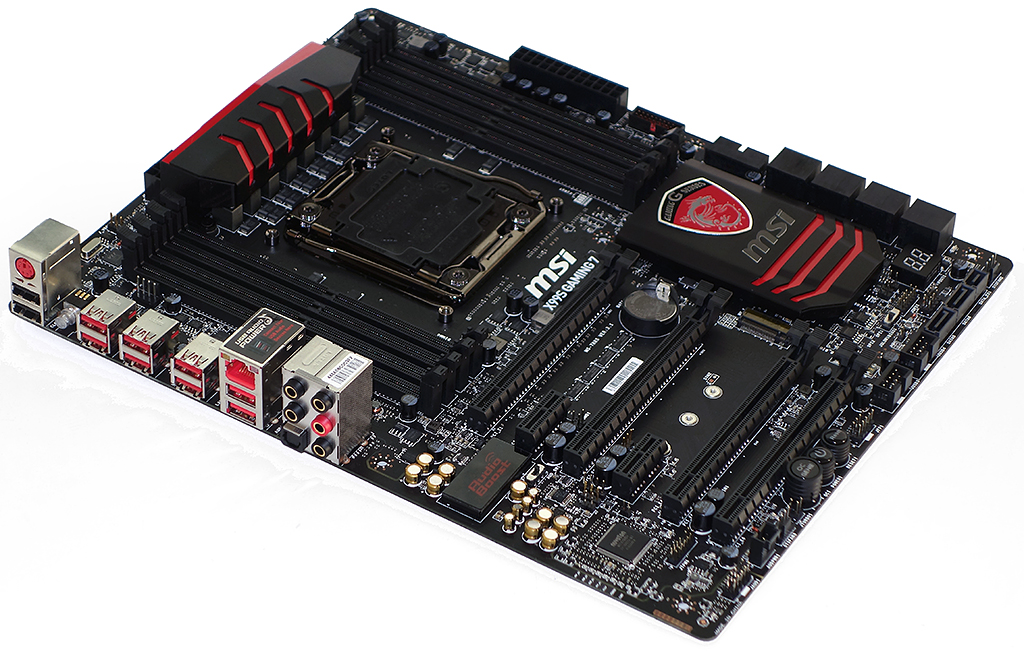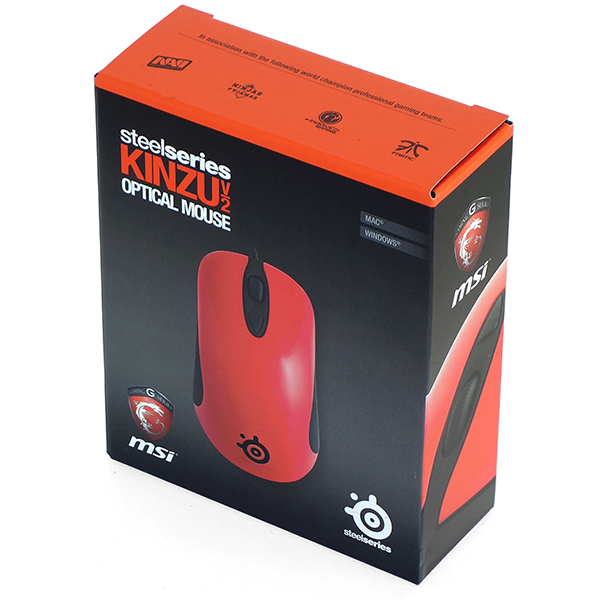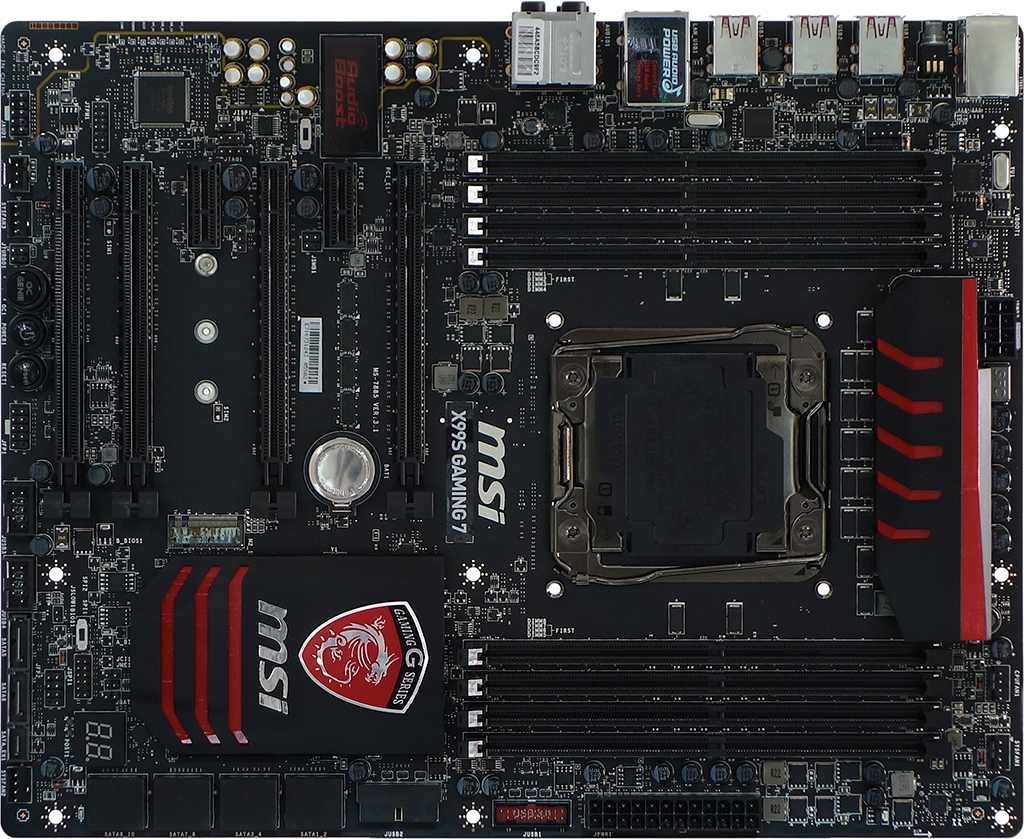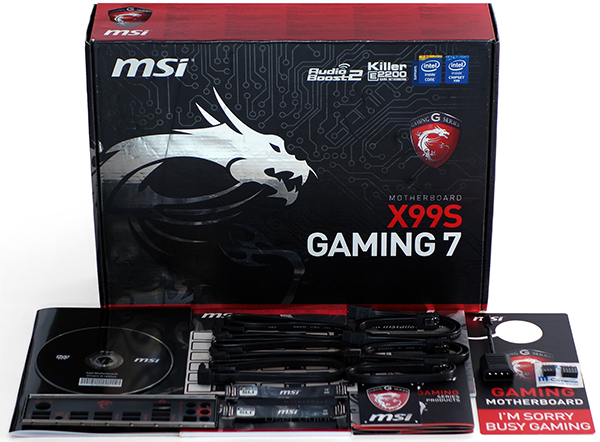Three-Way X99 LGA 2011-v3 ATX Motherboard Shootout
Buyers of Intel's X99 platform, which supports Intel's Haswell-E and new DDR4 memory, were probably prepared to pay a premium for mid-market boards. Are any of these $240 to $300 models worthy of Intel’s latest CPUs?
MSI X99S Gaming 7
A great-looking product with four PCIe 3.0 graphics card slots, the X99S-Gaming 7 is both the most feature-packed and expensive product in today’s round-up. A $30 premium over the competing Gigabyte sample buys another four USB 3.0 ports, a four-lane Ultra M.2 PCIe 3.0 slot, a Killer E2205 network controller and, for a limited time at Newegg, a free MSI Steelseries Mouse valued at $30.
X99S Gaming 7 owners also get a digital system code display, on-board power/reset/OC-profile buttons, and a selector switch to choose between two soldered-on firmware ROMs. Even if we ignore the temporary single-vendor mouse offer, the X99S Gaming 7 looks like it just might be worth more than its $30 price premium.
Yet, MSI is also the company known for most blatantly inflating its slot count through PCIe pathway sharing, and the X99S Gaming 7 is no exception. The Ultra M.2 interface shares lanes with the fourth PCIe 3.0 slot, so that installing a card there turns off all of the M.2 interface’s PCIe 3.0 lanes. Your PCIe-based SSD doesn't disappear though, because the X99S Gaming 7 instead switches it over to two of the chipset’s PCIe 2.0 lanes.
The illusions don’t end there. Supposing you have a 40-lane CPU like the Core i7-5960X or -5930K, MSI wants you to configure your three-way SLI in the motherboard’s first, second, and fourth slots. That gets you a x16/x16/(x0)/x8 configuration, while crippling the bandwidth of the M.2 slot.
Anyone who thinks that’s a rude thing to do to a potentially-32 Gb/s SSD will want to use the first, second, and third PCIe 3.0 slots for their graphics cards. The third slot borrows half of the first slot's lanes, yielding a x8/x16/x8 graphics configuration, no lanes to the bottom slot, and full PCIe SSD performance.
Value-minded enthusiasts who opt for the Core i7-5820K’s 28 lanes instead get a x16/x8/x0/x4 configuration. You'd need to drop to x16/x8/x0/x0 (no card in the forth slot) to get full Ultra M.2 performance, but you can still donate half of the top slot's bandwidth to the third slot for a x8/x8/x8/x0 three-way SLI configuration. Apart from the middle slot having only eight lanes, this is the configuration MSI recommended against when using a 40-lane CPU.
Could all of these marketing-based configuration recommendations be the reason why MSI calls this a three-way, rather than four-way board? Perhaps it’s just as likely that the single-slot spacing between PCIe 3.0 slot three and four is the culprit. Either way, MSI could have avoided the mixed configuration recommendations and M.2 bandwidth inconsistencies by leaving out the fourth slot. We might not prefer the board to have that alteration, but at least I wouldn’t have spent three paragraphs explaining it and an hour or so with a graphics card and an SSD confirming it.
Get Tom's Hardware's best news and in-depth reviews, straight to your inbox.
The rest of the X99 Gaming 7’s layout is close to spot-on, including a forward-facing USB 3.0 front-panel header that tucks easily under the top graphics card, and a second USB 3.0 header above that serves two more front-panel ports.
If we consider this a three-way SLI/CrossFire product, layout deficits become extremely minor. The upper half of the X99X Gaming 7 only has three fan headers (including CPU and rear panel) where we’d have preferred four, and the front-panel audio jack is still just a little too far into the bottom-rear corner to connect with the slightly-short cables of certain cases.
MSI provides a generous six SATA cables in two different lengths with the X99S Gaming 7, and even adds an optional power input cable to help boost audio output current. But the company is not as generous when it comes to SLI bridges. Rated for three-way SLI, the board lacks the extra-long third cable needed to jump from the top card to the bottom card.
Current page: MSI X99S Gaming 7
Prev Page Gigabyte X99-UD4 Firmware Next Page MSI X99S Gaming 7 Software-
west7 In the 3D gaming page it should been i7-5760x not i7-4790 and fix the LGA 2111-v3 typo and why there in no SLI/crossfire test?!Reply -
Daniel Ladishew Can't wait for them to review some of the other manufacturer's products in the X99 category. The ASUS board especially.Reply -
chiefpiggy Noob question: would my socket 1150 i5 4670k work with one of these motherboards or do I need one of the Haswell-E processors?Reply -
sportfreak23 Reply14199415 said:Can't wait for them to review some of the other manufacturer's products in the X99 category. The ASUS board especially.
+1 -
InvalidError Reply
LGA 2011 uses DDR3 while LGA2011-3 uses DDR4 so the sockets are different to prevent people from putting the wrong CPU in the wrong motherboard.14199118 said:"LGA 2111-v3"??
Did something change?
I think there were other changes but this is the big obvious one. -
firefoxx04 it should be mentioned (and maybe it was, just not on the first page) that you only get the 40 pci e lanes if you purchase the two higher tiered haswell-E chips. The lowest end model does not support 40 lanes, I think it supports 28.Reply -
vincevdc The MB grid on page one shows that the MSI X99S Gaming 7 mb has an Intel Z97 Express chipset. This is a typo...Reply




